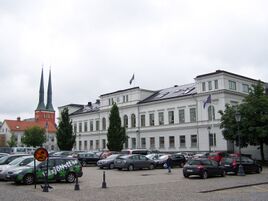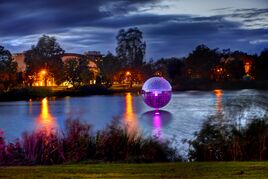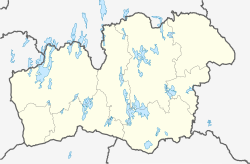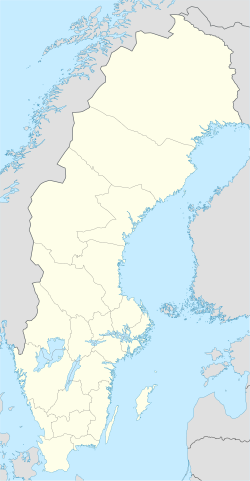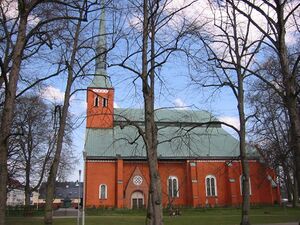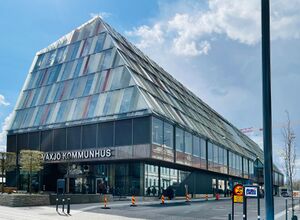ڤكخو
ڤكخو
Växjö | |
|---|---|
مبنى بلدية ڤكخو موقع فنون ڤكخو، الذي تأسس في 2008 | |
| الشعار: Europe's Greenest City | |
| الإحداثيات: 56°52′37″N 14°48′33″E / 56.87694°N 14.80917°E | |
| Country | Sweden |
| Province | Småland |
| المقاطعة | مقاطعة كرونوبرگ |
| Municipality | بلدية ڤكخو |
| المساحة | |
| • المدينة | 30٫28 كم² (11٫69 ميل²) |
| المنسوب | 167 m (548 ft) |
| التعداد (5 September 2017)[1] | |
| • المدينة | 66٬275 |
| • الكثافة | 2٬011/km2 (5٬210/sq mi) |
| • العمرانية | 90٬721 |
| منطقة التوقيت | UTC+1 (CET) |
| • الصيف (التوقيت الصيفي) | UTC+2 (CEST) |
| Postal code | 35x xx |
| مفتاح الهاتف | (+46) 470 |
| الموقع الإلكتروني | www |
ڤكخو ( Växjö ؛ النطق السويدي: [ˈvɛ̂kːɧøː] ويخطئ الناس بنطقها "فاكسيو")[2][3] هي مدينة ومقر بلدية ڤكخو، مقاطعة كرونوبرگ, Sweden. It had 70,489 inhabitants (2019) out of a تعداد البلدية 95,995 نسمة (2021). وهي المركز الإداري والثقاف والصناعي لمقاطعة كرونوبرگ و episcopal see لأبرشية ڤكخو ومقر كاتدرائية ڤكخو. البلدة هي مقر جامعة لينايوس.
أصل الاسم
The city's name is believed to be constructed from the words väg ("road") and sjö ("lake"), meaning the road over the frozen Växjö Lake that farmers used in the winter to get to the marketplace which later became the city.
التاريخ
In contrast to what was believed a century ago,[4] there is no evidence of a special pre-Christian significance of the site. The pagan cultic center of Värend may have been located at Hov, a nearby village.[5][6]
An episcopal see since the 11th century, the city did not get its city charter until 1342, when it was issued by Magnus Eriksson. The cathedral of St Sigfrid dates from about 1300, and has been subsequently restored.[7] Otherwise, during the Middle Ages, Växjö did not have many pious institutions. A Franciscan monastery was established in 1485. A hospital of the Holy Ghost was first mentioned in 1318. In the 14th century Växjö got its first school, Växjö katedralskola. In 1643 it received gymnasium status.
At the beginning of Gustav Eriksson's war of liberation, the peasantry joined forces, under the guidance of the union-hostile bishop Ingemar Pedersson, with the mountain men and peasantry of Dalarna, Hälsingland, and Gästrikland, who urged fidelity to their leader Gustav Eriksson. During the Dacke War, a peasant uprising, the city was under the authority of Nils Dacke and his supporters from the summer of 1542 until after New Year 1543.
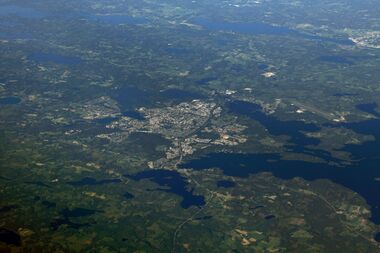
Several times during the Northern Wars and the Scanian Wars, and thereafter, the city was affected by fire (in 1277, 1516, 1570, 1612, 1658, 1690, 1749, 1753, 1799, 1838 and 1843). After the last fire in 1843, when 1,140 citizens were rendered homeless, Växjö received its current street plan.[8]
العصر الحديث
Växjö is the city in which the photograph "A Woman Hitting a Neo-Nazi With Her Handbag" was taken in 1985 by Hans Runesson.[9]
In its December 2015 report, Police in Sweden placed the Växjö district Araby in the most severe category of urban areas with high crime rates.[10]
المباني التاريخية
Växjö Cathedral is located near the centre of the city.
Immediately north of Växjö is Kronoberg Castle, a ruined fortress constructed in the 15th century. This castle was used as a base by the rebel, Nils Dacke, during the Dacke War. The fortress has thick walls and artillery portals that face north towards lake Helgasjön.
Teleborg Castle is also located near the city. It was built near the Linnaeus University in 1900, it now functions as a hotel and conference facility.
وسائل الراحة
The Swedish Emigrant Institute[11] was established in 1965 and is housed in the House of Emigrants near Växjö Lake in the heart of the city. It contains archives, a library, a museum, and a research center relating to the emigration period between 1846 and 1930, when 1.3 million (or 20%) of the Swedish population emigrated, mainly to the United States. Archives dating to the 17th century contain birth and death records, as well as household records, that are available on microfiche.
الصناعة
Industries include GE Power and Aerotech Telub, as well as Volvo Articulated Haulers which is located in Braås 29 كيلومتر (18 ميل), north of Växjö. One of the best-known service providers is Fortnox and Visma.
Växjö houses Sweden's National Glass Museum[12] and claims to be the capital of the "Kingdom of Crystal"[13] as well as of the "Kingdom of Furniture".[14] Växjö Linnaeus Science Park focuses on supporting entrepreneurs focusing on circular economy, smart city, forestry and digitalization.
التعليم
The city has three municipality-run secondary schools ("gymnasiums"): Teknikum, Katedralskolan, and Kungsmadskolan. Linnaeus University had a student body of 42,000 students اعتبارا من 2012[تحديث] (including its Kalmar campus)[15] or 15,000 students (full-time equivalents) اعتبارا من 2010[تحديث].[16]
السكان
|
| ||||||||||||||||||||||||||||||||||||||||||||||||
| Source: [17] | |||||||||||||||||||||||||||||||||||||||||||||||||
التعداد حسب الأحياء السكنية
- Teleborg: 12,834
- Hovshaga: 9,541
- Hov: 8,020
- Araby: 6,520
- Norr: 4,518
- Väster: 4,829
- Öster: 4,489
- Söder: 3,694
- Sandsbro: 3,090
- Högstorp: 2,710
- Öjaby: 2,213
- Centrum: 2,086
- Räppe: 1,260
- Kronoberg/Evedal: 279
- Regementstaden: 88
- Västra mark: 69
- Norremark: 29
النقل
The Coast to Coast track cuts through the municipality from north-west to south-east. SJ's long-distance trains travel between Gothenburg, Alvesta (with connections to the southern trunk line) and Kalmar, with stop in Växjö. Öresundståg's long-distance trains travel the Kalmar – Alvesta – Malmö - Copenhagen route. Regional trains Krösatågen travel the Växjö – Jönköping route. Trunk roads 23, 25, 27, 29, 30 and 37 meet in the municipality.
A new city hall and railway station building was completed in 2021.[18]
In air transport, the city is served by the nearby Växjö/Kronoberg Airport.
السياسة البيئية
In 1996 the city adopted a policy for the elimination of the use of fossil fuels by 2030.[19][20] This decision was taken in reaction to pollution and eutrophication in the lakes that surround the town. Greenhouse gas emissions were cut by 41% from 1993 to 2011, and were reduced by 55% by 2015. The city's economy has grown during this time.[21]
By 2014, Växjö's CO2 emissions had dropped to 2.4 tonnes per capita, well below the EU average of 7.3 tonnes.[22]
المدينة الأكثر اخضراراً في أوروپا
Växjö has called itself "The Greenest City in Europe" since 2007.[23] It has its foundation in a long history of commitment to environmental issues, and ambitious goals for a green future. It is a vision shared with the citizens and the local companies.
In 2017 Växjö was awarded the European Green Leaf Award 2018 by the European Commission. The prize is awarded to cities with less than 100 000 inhabitants that show good results and ambitions in terms of environment and are committed to generate green growth.
أبرز السكان
- Joachim Björklund, footballer[24]
- Jonas Björkman, tennis player with 50 doubles titles including Grand Slams
- Karl-Birger Blomdahl, 20th century music composer[25]
- Maria Cederschiöld (deaconess)
- Bjorn Englen, bass player of Yngwie Malmsteen's Rising Force
- Knute Heldner, 20th-century Swedish American artist
- Emil Johansson (ice hockey), Ice Hockey player for the Providence Bruins of the AHL
- Stefan Johansson, Formula 1 racing driver
- Jonas Jonasson, writer[26]
- Owe Jonsson, track and field athlete and European champion
- Martin Kellerman, comic strip creator
- Carolina Klüft, track and field athlete and Olympic gold medalist at Athens 2004
- Pär Lagerkvist, author and winner of the Nobel Prize in Literature, 1951
- Otto Lindblad, 19th century music composer
- Carl Linnaeus, botanist, physician and zoologist
- Melody Club, rock band[27]
- Christina Nilsson, 19th century soprano celebrity
- Andreas Ravelli, footballer
- Thomas Ravelli, football goalkeeper
- Sophie Sager, 19th century writer and feminist
- Peder Sjögren, 20th century author and playwright
- Jonas Swensson, President of the Augustana Evangelical Lutheran Church
- Håkan Syrén, a military General and Supreme Commander of the Swedish Armed Forces[28]
- Esaias Tegnér, poet and bishop of Växjö
- Per Tengstrand, pianist
- Mats Wilander, tennis player with seven Grand Slam victories 1982–1988
- Björn Wirdheim, racing driver[29]
- The Ark, rock band
الرياضة والترفيه
The following sports clubs are located in Växjö:
- Östers IF – football
- Hovshaga AIF – football, floorball, and tennis
- Växjö BK – football
- Växjö Lakers – ice hockey
- Växjö Vipers – floorball
- Wexjö RK – rugby
- Växjö Ravens BBK - basketball
- Växjö OK – orienteering
- Växjö DFF – football
- Växjö United FC – football
- Växjö VK – Volleyball
الطرق السريعة
- A speedway team rode at the Växjö Motorstadion, inaugurated on 5 June 1949 (the site of the current Räppe football pitch on Solängsvägen). They team competed in the 1950 Swedish speedway season before being the home for Dackarna in 1956. The venue held rounds of the Individual Speedway World Championship in 1952, 1957 and 1958.[30][31]
المناخ
Växjö has a humid continental climate (Dfb), using temperature data from 1961 to 1990. Temperatures have risen in recent years, and using the -3 Celsius isotherm, it can also be classified as an oceanic climate (Cfb)[32] with 2002-2015 temperature data. It is milder, wetter, and cloudier than the rest of the country, with the number of hours of sunshine being associated more with the British Isles than with areas further north in Sweden. Considering its relative distance to all three coasts surrounding South Sweden, the climate is markedly maritime, with winter temperatures being relatively mild for an inland location. When compared with sunnier inland areas further north, Växjö has relatively cool summers.[بحاجة لمصدر]
| بيانات المناخ لـ ڤكخو (المتوسط 2002–2018 ، القصوى منذ 1901) | |||||||||||||
|---|---|---|---|---|---|---|---|---|---|---|---|---|---|
| الشهر | ينا | فب | مار | أبر | ماي | يون | يول | أغس | سبت | أكت | نوف | ديس | السنة |
| القصوى القياسية °س (°ف) | 9.6 (49.3) |
13.8 (56.8) |
20.0 (68.0) |
27.9 (82.2) |
29.0 (84.2) |
32.5 (90.5) |
33.5 (92.3) |
34.4 (93.9) |
27.6 (81.7) |
21.9 (71.4) |
14.0 (57.2) |
11.3 (52.3) |
34.4 (93.9) |
| متوسط القصوى اليومية °س (°ف) | 0.5 (32.9) |
1.1 (34.0) |
5.4 (41.7) |
11.9 (53.4) |
17.0 (62.6) |
20.0 (68.0) |
22.5 (72.5) |
21.0 (69.8) |
17.0 (62.6) |
10.4 (50.7) |
5.5 (41.9) |
2.3 (36.1) |
11.2 (52.2) |
| المتوسط اليومي °س (°ف) | −1.7 (28.9) |
−1.4 (29.5) |
1.6 (34.9) |
6.8 (44.2) |
11.6 (52.9) |
14.7 (58.5) |
17.5 (63.5) |
16.4 (61.5) |
12.8 (55.0) |
7.2 (45.0) |
3.4 (38.1) |
0.3 (32.5) |
7.4 (45.4) |
| متوسط الدنيا اليومية °س (°ف) | −3.8 (25.2) |
−3.8 (25.2) |
−2.3 (27.9) |
1.6 (34.9) |
6.2 (43.2) |
9.4 (48.9) |
12.4 (54.3) |
11.8 (53.2) |
8.6 (47.5) |
4.2 (39.6) |
1.3 (34.3) |
−1.8 (28.8) |
3.7 (38.6) |
| متوسط الدنيا °س (°ف) | −13.8 (7.2) |
−12.1 (10.2) |
−10.0 (14.0) |
−3.6 (25.5) |
0.2 (32.4) |
4.2 (39.6) |
7.7 (45.9) |
6.7 (44.1) |
2.2 (36.0) |
−3.5 (25.7) |
−6.4 (20.5) |
−10.6 (12.9) |
−16.2 (2.8) |
| الصغرى القياسية °س (°ف) | −34.0 (−29.2) |
−28.8 (−19.8) |
−29.8 (−21.6) |
−19.0 (−2.2) |
−6.0 (21.2) |
−0.8 (30.6) |
3.5 (38.3) |
0.0 (32.0) |
−4.8 (23.4) |
−10.3 (13.5) |
−17.8 (0.0) |
−24.5 (−12.1) |
−34.0 (−29.2) |
| متوسط تساقط الأمطار mm (inches) | 50.5 (1.99) |
36.0 (1.42) |
31.7 (1.25) |
28.8 (1.13) |
51.6 (2.03) |
67.3 (2.65) |
89.6 (3.53) |
77.9 (3.07) |
49.4 (1.94) |
64.6 (2.54) |
57.0 (2.24) |
54.6 (2.15) |
659 (25.94) |
| Mean monthly ساعات سطوع الشمس | 32 | 57 | 143 | 203 | 236 | 238 | 234 | 191 | 153 | 88 | 37 | 24 | 1٬636 |
| Source 1: SMHI[33] | |||||||||||||
| Source 2: SMHI Monthly Data [34] | |||||||||||||
المراجع
- ^ أ ب "Tätorternas landareal, folkmängd och invånare per km2 2005 och 2010" (in السويدية). Statistics Sweden. 14 ديسمبر 2011. Archived from the original on 27 يناير 2012. Retrieved 10 يناير 2012.
- ^ قالب:Cite website
- ^ "Gopher Music Notes". 15 July 1994. Archived from the original on 5 March 2023. Retrieved 29 July 2022 – via Google Books.
- ^ "Växjö". Nordisk Familjebok. 1922. Archived from the original on 22 December 2023. Retrieved 26 December 2023.
- ^ Lars-Olof Larson (1999). "Land och län under kristendomen millennium". Landen kring sjöarna. p. 69. ISBN 91-86870-10-6.
- ^ Martin Hanson (2007). Det medeltida Småland – en arkeologisk guidebok. p. 137. ISBN 978-91-85377-93-0.
- ^
 Chisholm, Hugh, ed. (1911). . دائرة المعارف البريطانية. Vol. 28 (eleventh ed.). Cambridge University Press. p. 16.
Chisholm, Hugh, ed. (1911). . دائرة المعارف البريطانية. Vol. 28 (eleventh ed.). Cambridge University Press. p. 16. {{cite encyclopedia}}: Cite has empty unknown parameter:|coauthors=(help) - ^ "459-460 (Nordisk familjebok / Uggleupplagan. 33. Väderlek – Äänekoski)". Runeberg.org. Archived from the original on 24 October 2012. Retrieved 1 December 2012.
- ^ Merrill, Samuel (2020). "Following The Woman with the Handbag: Mnemonic Context Collapse and the Anti-Fascist Activist Appropriation of an Iconic Historical Photograph". In Merrill, Samuel; Keightley, Emily; Daphi, Priska (eds.). Social Movements, Cultural Memory and Digital Media: Mobilising Mediated Remembrance. Springer Nature. p. 119. ISBN 978-3-030-32827-6. Archived from the original on 17 February 2024. Retrieved 4 October 2020.
- ^ Utsatta områden - sociala risker, kollektiv förmåga och oönskade händelser (PDF). Police in Sweden - Nationella Operativa Avdelningen - December 2015. p. 29. Archived from the original (PDF) on 19 August 2016.
- ^ "Svenska Emigrantinstitutet". swemi.nu. Archived from the original on 26 August 2005.
- ^ "Hem". Press release. Archived from the original. You must specify the date the archive was made using the
|archivedate=parameter. https://kulturparkensmaland.se/. - ^ "Welcome to the Kingdom of Crystal!". Archived from the original on 23 October 2005.
- ^ "Lammhult". Lammhult.se. Archived from the original on 9 January 2013. Retrieved 1 December 2012.
- ^ "Färre studenter till 2015" (PDF). kalmar.se. Kalmar municipality. Archived from the original (PDF) on 19 نوفمبر 2016. Retrieved 19 نوفمبر 2016.
- ^ "Linnéuniversitetet - Uppslagsverk - NE.se". Archived from the original on 23 September 2012. Retrieved 9 March 2020.
- ^ "Växjö inhabitants (2013)". www.vaxjo.se. Archived from the original on 11 February 2007. Retrieved 1 December 2013.
- ^ "Invigning och öppet hus i nya kommunhuset". Mynewsdesk (in السويدية). 2021-10-13. Archived from the original on 8 June 2023. Retrieved 2023-06-08.
- ^ "The Swedish city touted as 'Europe's greenest'". The Local. 24 January 2014. Archived from the original on 23 May 2022. Retrieved 15 October 2015.
- ^ "The European cities moving faster on clean energy than their governments". The Guardian. 6 July 2015. Archived from the original on 3 July 2022. Retrieved 15 October 2015.
- ^ "Zero Net Emissions With Economic Growth? Europe's Greenest City Shows the Way". CSRwire. 6 July 2011. Archived from the original on 29 June 2017. Retrieved 15 October 2015.
- ^ "7 examples of sustainability in Sweden 2017 Växjö got the Green Leaf Award 2018 from EU-commission". Swedish Institute. 24 September 2015. Archived from the original on 6 August 2020. Retrieved 15 October 2015.
- ^ Slavin, Terry (25 November 2015). "What can the world learn from Växjö, Europe's self-styled greenest city?". Rockefeller Foundation via The Guardian. Archived from the original on 3 July 2022. Retrieved 28 July 2018.
- ^ "Dette er svensken som gjorde det Norling aldri klarte". 3 February 2017. Archived from the original on 23 February 2017. Retrieved 22 February 2017.
- ^ "Karl-Birger Blomdahl". AllMusic. Archived from the original on 25 February 2017. Retrieved 24 February 2017.
- ^ "Jonas Jonasson: My 100-year-old hero, and the secret of happiness". The Telegraph. Retrieved 22 February 2017.[dead link]
- ^ "Melody Club". AllMusic. Archived from the original on 23 February 2017. Retrieved 22 February 2017.
- ^ "Spionchefen Håkan Syrén blir ny ÖB". 17 November 2003. Archived from the original on 25 February 2017. Retrieved 24 February 2017.
- ^ Spurgeon, Brad (2 June 2003). "Motor Racing : Celebration costs driver victory on finish line". The New York Times. Archived from the original on 23 February 2017. Retrieved February 22, 2017.
- ^ "HISTORY SPEEDWAY and LONGTRACK". Speedway.org. Archived from the original on 10 September 2005. Retrieved 5 January 2024.
- ^ Oakes, Peter (1978). 1978 Speedway Yearbook. Studio Publications (Ipswich) Ltd. ISBN 978-0904584509.
- ^ "Vaxjo, Sweden Climate Summary". Weatherbase. Archived from the original on 23 September 2015. Retrieved 3 April 2015.
- ^ "SMHI Open Data for Växjö A" (in السويدية). Swedish Meteorological and Hydrological Institute. Archived from the original on 11 April 2019. Retrieved 2 May 2019.
- ^ "Yearly and Monthly Statistics" (in السويدية). Swedish Meteorological and Hydrological Institute. Archived from the original on 22 December 2013. Retrieved 2 May 2019.
وصلات خارجية
- Växjö Municipality – Official site
- Växjö tourist information in english
- (in سويدية)Växjö article in Nordisk familjebok
- Pages using gadget WikiMiniAtlas
- CS1 السويدية-language sources (sv)
- مقالات المعرفة المحتوية على معلومات من دائرة المعارف البريطانية طبعة 1911
- Articles with dead external links from July 2021
- Short description is different from Wikidata
- Pages using multiple image with auto scaled images
- Articles containing سويدية-language text
- Coordinates on Wikidata
- Pages with plain IPA
- Articles with hatnote templates targeting a nonexistent page
- مقالات فيها عبارات متقادمة منذ 2012
- جميع المقالات التي فيها عبارات متقادمة
- مقالات فيها عبارات متقادمة منذ 2010
- Articles with unsourced statements from March 2020
- Articles with سويدية-language sources (sv)
- ڤكخو
- County seats in Sweden
- Populated lakeshore places in Sweden
- Populated places in Kronoberg County
- Populated places in Växjö Municipality
- Municipal seats of Kronoberg County
- Swedish municipal seats
- Cities in Kronoberg County
- Värend
